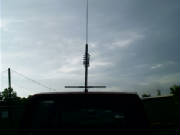|
SETTING YOUR SWR
( The Basics )
Regardless if you spent $50 or $2500 on your radio set up, it is only money wasted if you don't tune your antenna correctly.
If it isn't, you may not be heard, or worse, your radio or amp could spend more time on the workbench than in your mobile.
There are several things you should do on a regular basis and especially, before installing a new antenna.
Inspect your coax and connectors. Look for loose connections, corrosion, bad solder joints, damage on the coax jacket
or anything else that might indicate a problem. Check your mount for the same thing plus excessive wear, proper grounding,
and make sure all hardware is tight and clean.
Personally, I replace my coax once a year wether it needs it or not. I am not suggesting that everyone do this but a couple
of bucks once a year is much better than a high repair bill on my radio and amps.
To set the swr in a mobile, I prefer an antenna analyzer. They can be expensive but most CB shops have them and will not
charge much to do the job. For "the do-it-yourselfers", a good quality in line swr/power meter will do the fine. I prefer
these over the built in swr meters in some radios. What ever you use, if you are unsure of the accuracy, have it calibrated
at your local CB shop or use a friends meter and compare the reading with your own.
Assuming that most people will use the built in radio meters to set and monitor their swr, and most people will also transmit
on the 40 channel CB band, I will use this as my example.
While setting the swr, it is very important that you DO NOT speak into the keyed mic. until you have tuned your antenna properly.
Turn the power off to all amps, and adjust your variable power to the maximum dead key. On ch.1 set the meter switch to the
CAL position. Key the mic and turn the calibration knob until you get a full meter reading. Most meters have a small mark
at the end of the meter to align the needle with. Next, unkey the mic and switch the meter to the swr position. Again key
the mic and write down the swr reading. Repeat all the steps above on ch.40 including the calibration, and also write down
the meter reading. If the reading on ch.1 is higher than on ch.40, you will need to lengthen the antenna. If the reading on
ch.1 is lower than on ch.40, you will need to shorten the antenna. Since a lot of antennas adjust differently, refer to the
antennas instructions for proper adjustment. If the antenna has to be physically trimmed, be very careful! You can't put pieces
back on after you cut them off! Repeat the steps above until the swr on ch.1 and ch.40 are the same.
If it is possible, try to achieve an swr of 1.5:1 or less for best performance. Many people might disagree but I never
key an amp with a swr over 1.5:1. That is my personal opinion. Some people don't worry until they get around 2.0:1 and some
have told me that anything above 1.1:1 will not do. I find it very difficult and sometimes impossible to archive a 1.1:1 in
a mobile due to all the variable conditions. When I tune a new antenna for a customer, It will show a 1.1:1 swr @ 50 ohm impedance
on my meter before it goes in the box. BUT, that is on my bench in a controlled environment. You can not achieve a controlled
environment in any mobile installation, period. I am not saying that a 1.1:1 is not possible, it is just difficult.
For future reference, copy, paste and print the section below and put it in your mobile to help you remember when tuning
your antenna
.
HIGH ON CH.40, LOW ON CH.1
SHORTEN THE STINGER.
LOW ON CH.40, HIGH ON CH.1
LENGTHEN THE STINGER.
SWR
%OF LOSS* ERP**
1.0:1
0
100.0
1.1:1
0.3 99.7
1.2:1
0.8 99.2
1.3:1 1.7 98.3
1.4:1 2.7 97.3
1.5:1
3.0 97.0
2.0:1
11.0 89.0
3.0:1
25.0 75.0
4.0:1 38.0 62.0
5.0:1
48.0 52.0
6.0:1 55.0
45.0
10.0:1 70.0 30.0
* % OF LOSS = Is the percentage of current that is not converted
to signal. It is converted to heat instead.
** ERP = effective radiated power is the amount of current
that is converted to signal. The ERP tells you how efficient the antenna actually is.
© Copyright 2007 Crossbones Antennas. All Rights Reserved. Click here for more information.
| CROSSBONES WASP |

|
| NEW CROSSBONES MAGNUM |

|
|
